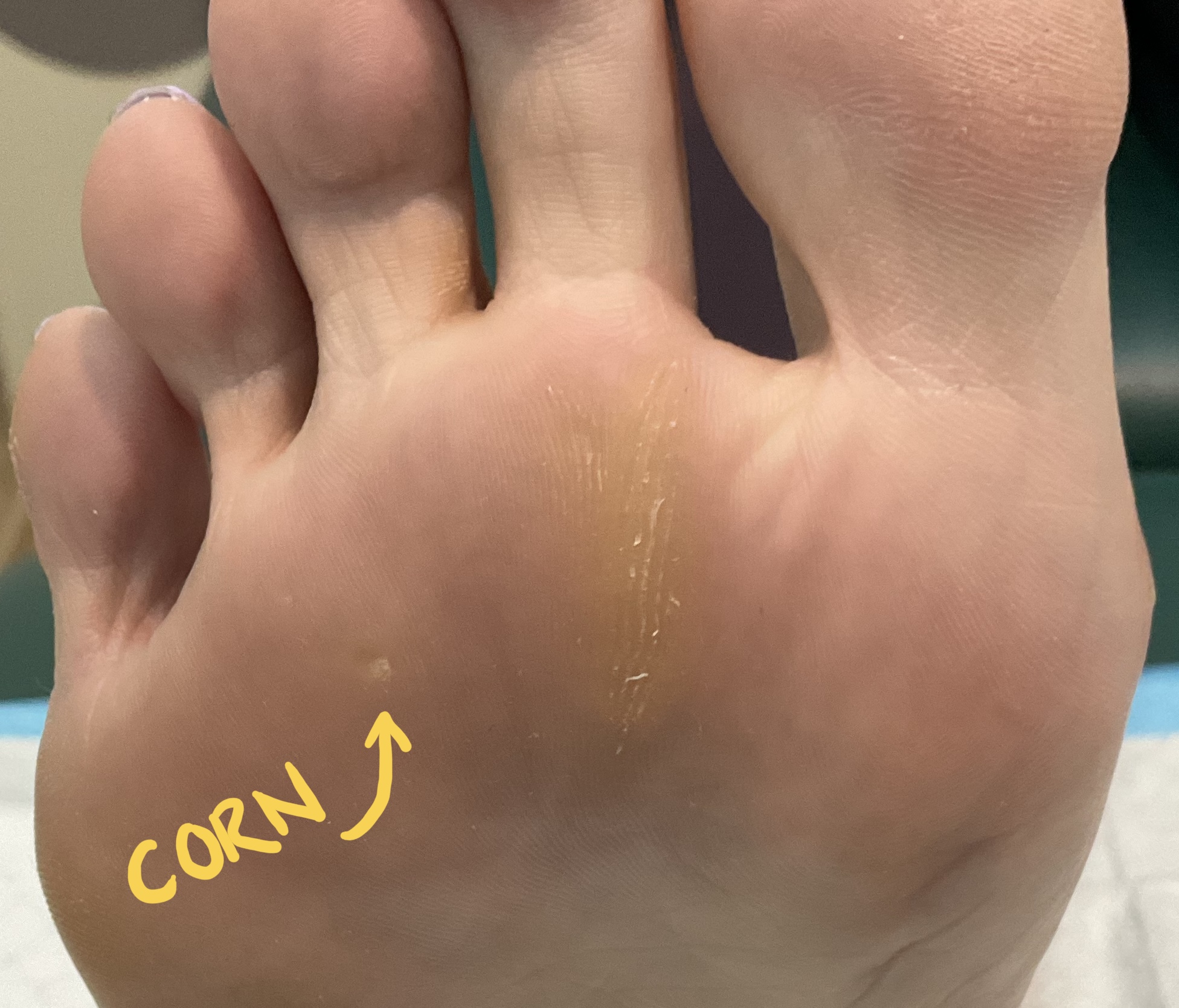What is a Corn?

Explainer video
Plantar corns are a common condition that affects many individuals, particularly those with persistent mechanical stress on their feet. They often occur on the plantar aspect (bottom) of the foot, typically beneath weight-bearing areas like the ball of the foot or heel. In this article, we will explore the pathology of plantar corns, their causes, and effective treatments.
Plantar corns are a common condition that affects many individuals, particularly those with persistent mechanical stress on their feet. They often occur on the plantar aspect (bottom) of the foot, typically beneath weight-bearing areas like the ball of the foot or heel. In this article, we will explore the pathology of plantar corns, their causes, and effective treatments.
What Are Plantar Corns?
Corns are localized areas of thickened skin that develop in response to pressure or friction. They are distinct from calluses, which cover broader areas of the foot. Corns, particularly plantar corns, are usually smaller, more concentrated, and may cause significant pain when walking or standing. Corns can be either hard or soft, with hard corns more commonly found on the plantar surface or the top of toes (Freeman, 2002)
Pathophysiology of Plantar Corns
Plantar corns form as part of the skin’s natural defense mechanism against excessive mechanical stress. The epidermis, the outermost layer of the skin, responds to repeated pressure by producing an excess of keratin (hyperkeratosis), which results in the characteristic hardened area of skin known as a corn.
The pathology of corns involves several key factors
Pressure concentration: When excessive pressure is focused on a small area, such as beneath a metatarsal head or on a bony prominence, it can lead to corn formation. This is common in individuals with foot deformities, such as hammertoes or bunions, or in those who wear ill-fitting shoes.
Increased keratin production: The friction or pressure signals the skin to increase its production of keratin, which causes the thickened, protective layer of skin to form. Over time, this layer can become painful as it compresses underlying tissues.
Ischemic changes: Prolonged pressure can restrict blood flow to the area, leading to tissue damage and increased sensitivity. This is particularly important in high-risk groups such as those with diabetes, who may experience reduced sensation in the feet and thus allow corns to develop unnoticed.
Factors Contributing to Corn Development
Several factors may contribute to the formation of corns, particularly on the plantar surface of the foot:
Footwear: Shoes that are too tight, too loose, or have inadequate cushioning can exacerbate pressure on specific areas of the foot. High heels, for example, increase pressure on the forefoot, making corns more likely to form beneath the metatarsal heads.
Biomechanical abnormalities: Abnormal gait patterns, foot deformities, or conditions like pes cavus (high arches) or pes planus (flat feet) can increase stress on certain areas of the foot, leading to corn development. Studies have shown that improper foot mechanics are a major factor in the development of plantar keratotic lesions, including corns.
Occupation and lifestyle: Those who spend long periods standing or walking on hard surfaces are more likely to develop plantar corns due to the constant stress placed on their feet.
Age and skin changes: Older individuals are more prone to corns because their skin becomes thinner and loses its natural elasticity, making it more susceptible to damage from pressure.
Diagnosis and Differential Considerations
Plantar corns are typically diagnosed through clinical examination. A podiatrist can usually identify the condition based on the location, appearance, and the patient’s history of foot pain or footwear habits. It is important to distinguish corns from other skin conditions such as:
Plantar warts: Often confused with corns, plantar warts are viral in origin and usually appear with black dots (capillaries) and may bleed when trimmed.
Calluses: A broader area of thickened skin with less defined borders than a corn.
Metatarsalgia: Pain in the ball of the foot that may coexist with corns, but it stems from inflamed soft tissues rather than thickened skin.
Treatment Options for Plantar Corns
Treating plantar corns involves addressing both the symptom (the corn itself) and the underlying cause (mechanical stress).
Orthotics and Footwear: Proper fitting shoes with sufficient toe room and cushioning to distribute pressure more evenly across the foot together with Podiatrist prescribed custom-made orthotics can provide relief by correcting biomechanical issues and reducing pressure on specific areas of the foot.
Debridement: Regular removal of the thickened skin by a healthcare professional can provide immediate relief. This process involves shaving down the hardened tissue with a scalpel to reduce the bulk of the corn.
Surgical intervention: In rare cases where foot deformities are the primary cause of recurrent corns, surgical correction may be considered to alleviate the underlying pressure.
Preventing Plantar Corns
Prevention strategies focus on reducing pressure on vulnerable areas of the foot. Wearing appropriately fitting shoes, using custom orthotics to address biomechanical issues, and maintaining good foot hygiene can all help to reduce the risk of corn formation. Regular moisturizing can also prevent the skin from becoming excessively dry and thickened.
Plantar corns develop due to excessive pressure on specific areas of the foot, leading to thickened skin as a protective response. By understanding the pathology and addressing the underlying causes of pressure, patients can achieve both symptom relief and long-term prevention. For individuals struggling with recurrent plantar corns, consulting a podiatrist is essential for proper diagnosis, treatment, and management.
References
1. Freeman, D.B., 2002. Corns and calluses resulting from mechanical hyperkeratosis. American family physician, 65(11), pp.2277-2280.
References
1. Freeman, D.B., 2002. Corns and calluses resulting from mechanical hyperkeratosis. American family physician, 65(11), pp.2277-2280.
Mark Reyneker
B.T. Pod (SA), MSc (SA)
Podiatrist and Human Gait Specialist
Registered with the Podiatry Association of Singapore
Founder and Director:
Family Podiatry Centre Pte Ltd
Family Podiatry Centre Sdn Bhd
Solescape Orthotics Laboratory
Solescape Shoes brand
